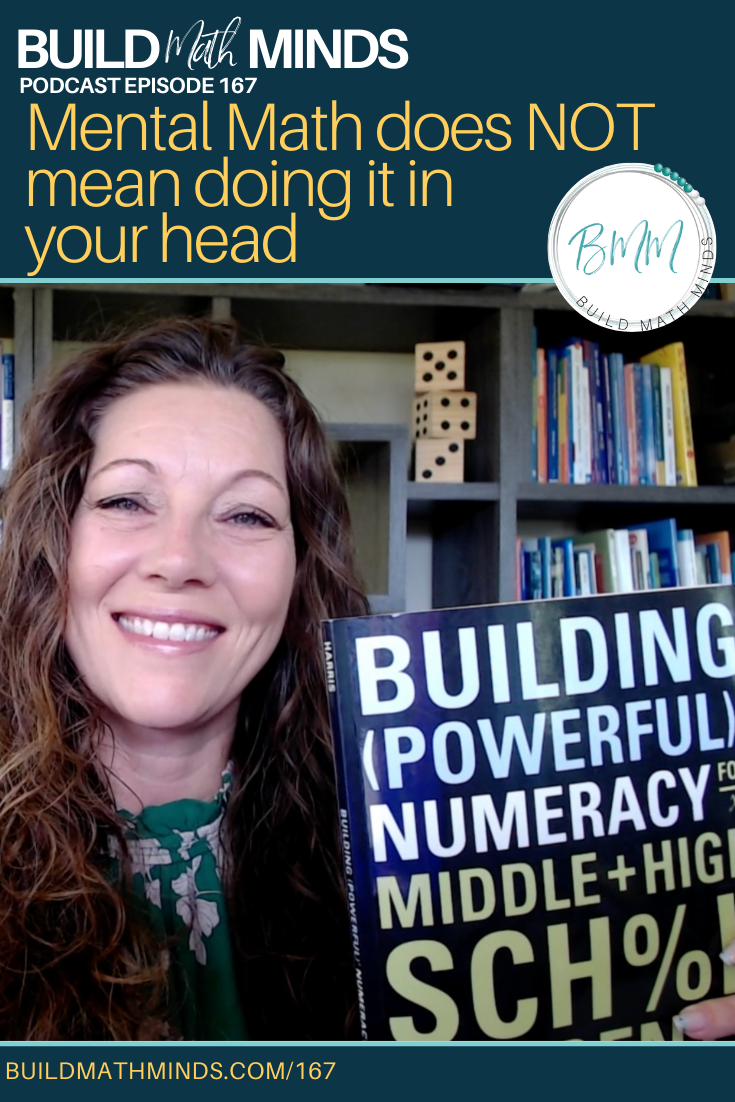Join the Waitlist for K-2 Flexibility Formula Course or the 3rd-5th Flexibility Formula Course
Building Powerful Numeracy for Middle & High School Students by Pam Harris
The youtube video for this episode
Welcome fellow Recovering Traditionalists to Episode 167: Mental Math does NOT mean doing it in your head.
Before we get into the episode, this week’s positivity comes from a paper sent in by a participant in one of my Flexibility Formula courses:

In a few weeks I’ll be opening up registration to my online courses for teachers, The Flexibility Formula, which are all about how kids in K-5 build their flexibility with numbers. We have some special gifts to people who enroll early but the only way to get the link to enroll early is to be on the waitlist for the courses. You can go to BuildMathMinds.com/courses then click on the link of the course you are interested in to learn more and join the waitlist or go to the show notes page for this episode and I’ll have each course (the K-2 and the 3-5) linked up for you.
The inspiration for this episode comes from the book Building Powerful Numeracy for Middle & High School Students by Pam Harris. Even though this book is geared towards helping Middle & High School teachers, I love it because one of the common complaints I hear from elementary teachers is that they can’t spend time building number sense and strategies with their students because the middle & high school teachers expect them to just know procedures and memorize. However, this book (and others) show that not ALL secondary teachers feel that way plus even if they all did, laying a foundation of number sense and strategic thinking in math will help your students be able to make sense of the mathematics even when teachers only teach them the procedures.
So all that to say, even if you work with elementary kids I still recommend this book to see how the work you are doing in the elementary school can be transferred to helping middle and high school students understand mathematical concepts.
For our purposes in this episode I’d like to share a very tiny part of the book that had a huge impact on me. On pages 4 & 5 there is one paragraph about Mental Math:
“Doing mental arithmetic does not mean doing it all in your head. Instead, it implies that you are using your head to reason. Many who employ the strategies suggested in this book use paper and pencil to keep track of their mental steps. This is different from writing down numbers and performing a predetermined set of steps that have been memorized without understanding.”
Doing mental arithmetic does NOT mean doing it all in your head. Instead, it implies that you are using your head to reason.
Think that over.
When you are asking students to do Mental Math, are you requiring them to do it all in their head?
We should be emphasizing Mental Math as a time to think through a problem and then allowing students to write down or draw out what is happening in their mind. On page 5 right after the Mental Math paragraph is information about the importance of representation and I don’t think that was by accident. We need to help students take what they are doing in their head and represent it on paper in some way. A way that actually represents what they did in their head to solve the problem.
On page 6, Pam writes “…many well-meaning teachers ask students to show their work. But they do not really mean, ‘Show your work.’ They actually mean, ‘Show my work. Mimic me. Show all of my steps in solving that problem.’”
If we want to really build students’ ability to think through math problems, even solve problems mentally, we need to allow them to use their head to think through problems then represent their own thinking on paper. If you are saying, but my students only know the algorithm…they even do that in their head. Well then your students are just like I was once. When I had to do math in my head I could only do the algorithm. Because I was taught to just mimic my teacher’s work. To actually use your head to do math, you have to understand how numbers relate and how to use those relationships to make problems easier and faster to do.
That’s what we explore in my online courses, The Flexibility Formula. It’s for elementary teachers to help you understand the number relationships kids need to build in K-2 and in 3rd-5th. These number relationships are what allow students to manipulate and use numbers in ways that make solving math problems easier and often faster than the algorithm and allow them to use their head, not just do the algorithm mentally, to do Mental Math.
The course will be opening up for registration on May 16th and if you are interested we have a special gift for anyone who registers early on May 14th or 15th. But we are only sending out the link to register on those two days to people who are on the waitlist.
Until next week my Fellow Recovering Traditionalists, keep Building Math Minds.




